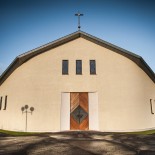Social and Economic Life
In prehistoric times the Bann provided a highway for the transportation of ancient implements, hides and goods. Many of these ancient implements were discovered in the bed of the River Bann at the time of the Drainage Scheme in 1936 and some local men who worked on the Scheme still have these prehistoric tools and implements in their possession. Samples may be seen at St Mary’s Primary School, Greenlough and Greenlough Bar used to have a collection of these items.
Later, the river provided an easy route for incursions by the invading Scots, Danes and English. These invaders plundered the settlements and monastic houses and churches in the Bann Valley and further afield before retreating down the river to the sea. The foreigners noted the rich fisheries of salmon, trout, pollan and eel. These proved one of the chief attractions for the undertakers at the time of the Plantation of Ulster.
The people of this district were a rural people who made the most of their resources. Previous to the Plantation (17th century) the countryside was densely wooded with a great forest stretching from the Tyrone border to beyond Kilrea. Agriculture and fisheries were the main occupation and the inhabitants had highly developed skills in exploiting these natural resources. They had a high sense of conservation and did not exhaust the resources but carefully conserved timber, spawning beds, hunting grounds and soil and peat for future years. Sadly, after the Plantation, these natural resources were over-exploited and some of them permanently ruined by the new settlers.






